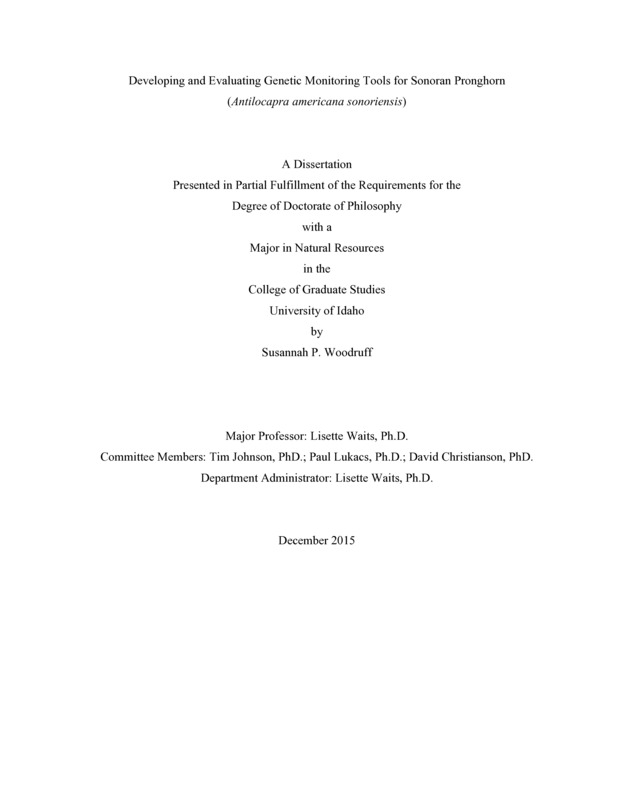Developing and Evaluating Genetic Monitoring Tools for Sonoran Pronghorn (Antilocapra americana sonoriensis)
Woodruff, Susannah P.. (2015). Developing and Evaluating Genetic Monitoring Tools for Sonoran Pronghorn (Antilocapra americana sonoriensis). Theses and Dissertations Collection, University of Idaho Library Digital Collections. https://www.lib.uidaho.edu/digital/etd/items/woodruff_idaho_0089e_10751.html
- Title:
- Developing and Evaluating Genetic Monitoring Tools for Sonoran Pronghorn (Antilocapra americana sonoriensis)
- Author:
- Woodruff, Susannah P.
- Date:
- 2015
- Keywords:
- Antilocapra americana sonoriensis Capture-mark-recapture DNA Noninvasive genetic sampling Simulations Sonoran pronghorn
- Program:
- Natural Resources
- Subject Category:
- Wildlife conservation; Wildlife management
- Abstract:
-
The Sonoran desert is home to the Sonoran pronghorn (Antilocapra americana sonoriensis), an endangered species with populations once numbering in the thousands and now reduced to fewer than 300. Monitoring of the population is limited to biennial counts which provide abundance estimates, but do not provide information on other demographic parameters. Pronghorn are sensitive to stress from physical capture making them good candidates for using noninvasive genetic methods. Noninvasive genetic sampling has commonly been utilized in carnivores, but is less developed in ungulates. We designed and implemented a method combining noninvasive genetic sampling and capture-recapture (NGS-CR) methods to monitor Sonoran pronghorn. One weakness of fecal DNA analysis methods is the difficulty of aging individuals with noninvasive genetic samples. We developed a model using several measures of pellet morphology to reliably classify pellets from fawn versus yearling and fawn versus adult using five-fold cross validation. We used our method of NGS-CR to estimate abundance and apparent annual survival and assessed the accuracy and precision of our estimates using capture-recapture simulations. While the inference of our estimates were limited to the population using watering holes (drinkers), our results indicate this methodology provided reasonable and precise abundance estimates though biased slightly low. Combining this method with radio-telemetry data would further improve the accuracy of the population estimate. As the population continues to expand, this method allows managers to monitor trends in abundance and survival as an indicator of the population’s trajectory, as opposed to current aerial survey methods, which provide abundance estimates, but are costly and do not provide information on survival or other demographic parameters.
- Description:
- doctoral, Ph.D., Natural Resources -- University of Idaho - College of Graduate Studies, 2015
- Major Professor:
- Waits, Lisette P
- Committee:
- Lukacs, Paul M; Christianson, David; Johnson, Timothy R
- Defense Date:
- 2015
- Identifier:
- Woodruff_idaho_0089E_10751
- Type:
- Text
- Format Original:
- Format:
- application/pdf
- Rights:
- In Copyright - Educational Use Permitted. For more information, please contact University of Idaho Library Special Collections and Archives Department at libspec@uidaho.edu.
- Standardized Rights:
- http://rightsstatements.org/vocab/InC-EDU/1.0/

